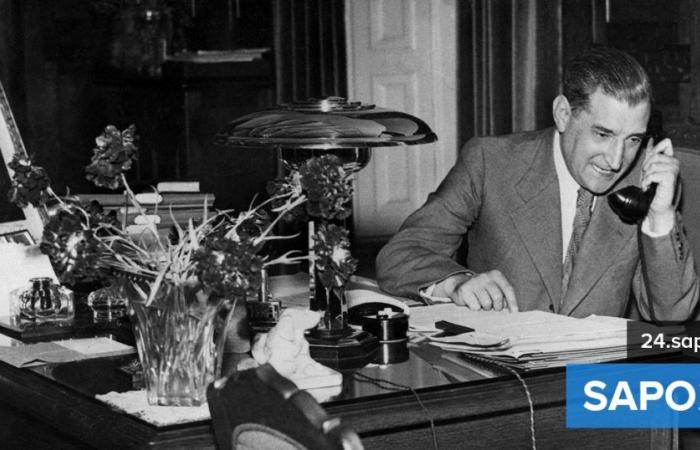Among roads, avenues, streets, lanes, alleys, alleys, squares, squares, stairs, sidewalks, alleys, yards, squares, bridges and neighborhoods, hundreds of toponyms of protagonists of the Estado Novo remain in the public space, according to with the CTT – Correios de Portugal database provided to the Lusa agency, although Humberto Delgado or Aristides de Sousa Mendes also remain as symbols of resistance in the dictatorship.
Surviving the initiative to erase the ideology and memories of 48 years of dictatorship, after the 25th of April 1974, at least 17 streets maintain the name of António de Oliveira Salazar, who governed between 1932 and 1968, first as Minister of Finance and then as president of the Council of Ministers (prime minister).
In Santa Comba Dão, district of Viseu, the dictator who was born in the old parish of Vimieiro gives his name to the avenue (and nickname to the school), in Armamar, in the same district, stands out with another avenue, square and alley, in Castelo Branco and Leiria, with two streets, and Ansião (Leiria), Cadaval (Lisbon), Carregal do Sal and Penodono (Viseu), Odemira (Beja), Santo Tirso (Porto), Tomar (Santarém), Vila Flor (Bragança), Vila Nova de Gaia (Porto), mostly with one street each.
In Salazar’s seat was succeeded Marcelo Caetano, last prime minister of the Estado Novo, who surrendered in the Carmo Barracks in the “carnation revolution”, with 16 plaques, on four streets in Pombal, in different places or parishes, and an alley in Peniche, in the district of Leiria, two streets and square in Cadaval, avenue and square in Maia (Porto), square in Arganil (Coimbra), lane in Penalva do Castelo (Viseu), and streets in Rio Maior and Tomar (Santarém) and Cascais and Sintra (Lisbon).
The last President of the Republic of the Estado Novo, Américo Tomás, an admiral called “ribbon cutter” by the people, gives his name to the avenue in Covilhã (Castelo Branco), and streets in Celorico da Beira (Guarda), Ferreira do Zêzere (Santarém) , and Cadaval and Loures (Lisbon).
Marshal Francisco Craveiro Lopes, President of the Republic between 1951 and 1958, appears on 16 plaques on two streets in Loures and Odivelas (Lisbon), avenues in Vendas Novas (Évora), Cascais and Lisbon, and a street in Almeirim, Santarém, Bragança , Castelo Branco, Mirandela (Bragança), Peniche, Ponte de Sor (Portalegre), Santa Maria da Feira (Aveiro) and Vila Nova de Gaia.
General Óscar Carmona, head of State between 1926 and 1951, has 41 toponymic references, from avenues in Cascais (two and one street), in Chaves (Vila Real), Santa Comba Dão, Tabuaço (Viseu) and Vila Flor, and streets also in the districts of Aveiro, Beja, Bragança, Castelo Branco, Faro, Leiria, Lisbon, Porto, Santarém and Viseu.
Carmona also gives its name to squares in Alcanena and Entroncamento (Santarém), Castelo Branco and Felgueiras (Porto), squares in Anadia (Aveiro), Fronteira (Portalegre), Leiria and Odivelas, and a bridge in Vila Franca de Xira (Lisbon) .
Marshal Gomes da Costa, a monarchist who was President of the Republic in 1926, deposed by a coup led by Carmona, has 35 toponyms, and Carrazeda de Ansiães (Bragança) leads in number, with two streets and a lane, followed by Almeirim with two streets, or Nisa (Portalegre) and Portimão (Faro) with one street and one lane each.
The marshal’s name is also visible on avenues in Oeiras, Lisbon, Matosinhos, Vila Nova de Gaia and Porto, as well as on streets in Horta (Azores) and municipalities in the districts of Beja, Braga, Beja, Coimbra, Évora, Guarda, Leiria , Lisbon, Portalegre, Viseu, Santarém or Setúbal.
The writer and journalist António Ferro names the street and square in Cascais, the streets in Amadora (Lisbon), Matosinhos, Portalegre and Portimão and the square in Oeiras.
At least 72 toponyms in the districts of Aveiro, Beja, Bragança, Castelo Branco, Coimbra, Évora, Faro, Leiria, Lisbon, Porto, Santarém, Setúbal, Viana do Castelo and Vila Real are named after Duarte Pacheco, an engineer who was minister of Public Works and responsible for projects such as Lisbon airport and the Salazar Bridge, renamed Ponte 25 de Abril, which connects Lisbon to Almada.
The Portuguese consul in France Aristides de Sousa Mendes, who granted visas to Jews fleeing the Nazi German army in the Second World War without Salazar, records 63 place names in the districts of Aveiro, Beja, Braga and Bragança. Coimbra, Faro, Guarda, Leiria, Lisbon, Porto, Santarém, Setúbal, Viana do Castelo, Vila Real, Viseu.
General Humberto Delgado, who tried to overthrow the Salazar regime through elections, has 448 toponyms, with emphasis on Sintra, with 17 signs on four avenues, nine streets, two squares and two lanes, in different places or parishes, followed by Loures, with 16, including 12 streets, two squares and a square.
In addition to the toponymy, figures from the Estado Novo are also present in the statuary or on the Duarte Pacheco bridge and viaduct, in Penafiel and Lisbon, respectively.






